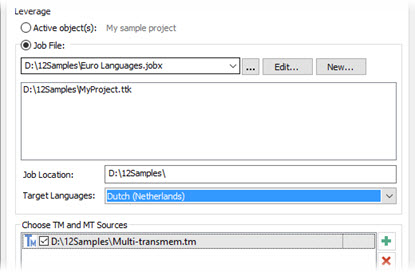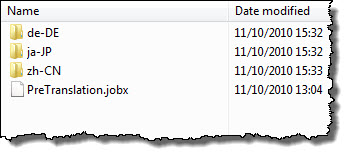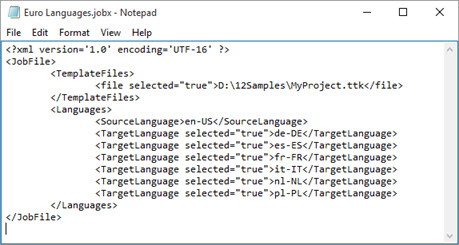|
|
What is a Job File? |
|
|
What is a Job File? |
A Job file is used by the Scheduler to run Alchemy Experts as background tasks. Engineers and Project Managers that need to work across several target languages simultaneously will use Job files to schedule tasks that can be run using available computing resources on a desktop machine.
|
|
In previous versions of Alchemy CATALYST, ezScript was used to work across multiple Project TTKs. The Scheduler greatly simplifies this task and helps Project Managers and Engineers achieve higher levels of task automation and higher levels of productivity. |
For example, a Project Manager may be running several large project analysis tasks in the background while he's working on checking the quality of the translations using the Validate Expert.
A Job file consists of the following components:
|
|
Source Project TTKs |
|
|
A Job file can contain several source Project TTK files. This makes it very easy for Project Managers and Engineers to work across multiple TTKs in several target languages. |
|
|
Source & Target Languages |
|
|
Each Job file can have one source language and several target languages defined. |
|
|
Target Folder |
|
|
This is the output folder that will be used to store the outputs of each Job submitted to the Scheduler. |
You can specify a Job File when you launch many of the Alchemy Experts. This means that you can run these as background tasks on your machine and across many project TTKs simultaneously.

This is a very powerful mechanism for working with multi-lingual projects. For example, it is now possible to launch the Analysis Expert and run several multilingual analysis reports simultaneously on your desktop.
A Target folder is defined as part of a Job. The Job file (.jobx) will be stored in the root of this folder.
However, within this target folder, a language folder will be created for each target language defined in a Job. Alchemy uses the RFC 1766 Standard as a guide for the naming convention for these folders. So if a target language of German (Germany) is defined in a Job, a target folder de-DE will be automatically created.

In the example above, the Scheduler has created a folder for the following target languages; German (Germany), Japanese (Japan) and Chinese (Simplified, PRC).
When the Scheduler processes a Job, it will create copies of your source Project TTKs in these language folders. It will also set the source and target languages appropriately for each target language defined in a Job file. These are then used as input to any of the scheduled Experts that the Scheduler processes.
|
|
The Scheduler will only make a copy of a source Project TTK if it doesn't exist in a language folder. If the file already exists in the language folder, the Scheduler will use it an input. |
For example, if you use a Job file with the Validate Expert, the files that are processed will be the ones located in these language folders and not the original source Project TTKs.
A Job file is stored as an XML document (.jobx) and can be created using File-> New Job or by any Content Management System (CMS) that can work with XML documents.

If a Job file is used by an Alchemy Expert, it will be dispatched to the Scheduler and run in the background of your computer using available computer resources. This makes it possible to sequence and schedule many tasks and have Alchemy CATALYST process them when resources are available on your machine.